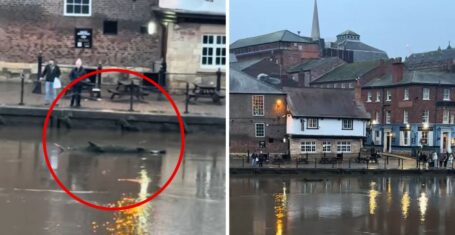
Northern Lights mesmerise Cambridge stargazers
The obligatory Instagram photos came out in full force
If you somehow missed the hundreds of aesthetic Instagram silhouette posts, the capitalised group chat texts to LOOK OUTSIDE, or the hoards of people walking, running, and cycling up to Castle Mound last night, then this may be the first time you hear that the northern lights were seen across the whole of England last night.
Last night, I was among the many frantically scrambling up Castle Mound at around midnight to try and get a clearer view of the spectacle after seeing photos all over Instagram and Snapchat. Bikes and revision alike were left abandoned at the bottom of the hill, as eager viewers in formal gowns and dressing gowns gazed up at the sky, hoping for a glimpse of this extremely rare cosmic event.

View from Castle Mound, Image credit: Izzie Iveson
What caused this phenomenon?
Whilst the northern lights are occasionally seen in the north of England and parts of Scotland and Northern Ireland, it is very rare for them to be seen this far south. However, last night an incredibly strong geomagnetic storm hit Earth, classed as the highest level G5 by the US National Oceanic and Atmospheric Administration (NOAA), causing the lights to be seen much further south than usual, across almost the whole of England.

Image credit: @cambridgeuniversity Instagram
What causes the northern lights more generally?
The northern lights occur as a result of sunspots on the surface of the sun hurling charged particles across space. When these energised particles hit Earth at speeds of up to 45 million mph, the upper atmosphere protects us from the attack, and the particles are redirected towards the poles by the Earth’s magnetic field.
Most Read
This causes the northern lights (aurora borealis) in the Northern hemisphere and the southern lights (aurora australis) in the Southern hemisphere, as viewers can see these particles interacting with Earth’s atmosphere and magnetic field, causing them to fluoresce.
Why are the northern lights usually pink and green?
The Earth’s atmosphere is made up mostly of nitrogen (78 per cent) and oxygen (21 per cent). When hit by the electrons (sorry for the painful flashbacks to GCSE Chemistry) from the charged particles hurled out by the sun, nitrogen particles emit a pinkish-purple light, while oxygen emits the green light that is typical of the northern lights, with very high altitude oxygen occasionally emitting a bright scarlet light. This elemental mixture is what causes the glowing array of colours that lit up the sky all across England last night.

The lights could be seen from the south coast of England, Image credit: Rebecca Dyer
Where can I see the northern lights tonight?
For many, this was believed to be a once in a lifetime opportunity to see the northern lights without travelling to Iceland or Norway. However, in case you were tucked up in bed asleep, there is still hope to see this magical event. Experts believe that the aurora borealis may also be visible tonight in some parts of England, and whilst the colours may not be as vibrant as last night, there should still be relatively clear skies which is ideal.
For the best chances of seeing the northern lights, try to get as far as possible away from city lights and light pollution. Even if the lights are not visible this far south tonight, as experts are still discussing where they are likely to be seen in England, it should still be a beautiful night for stargazing!
Featured Image Credit: Bianca Mirpuri



















